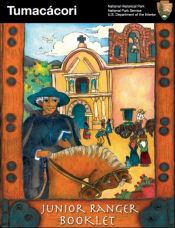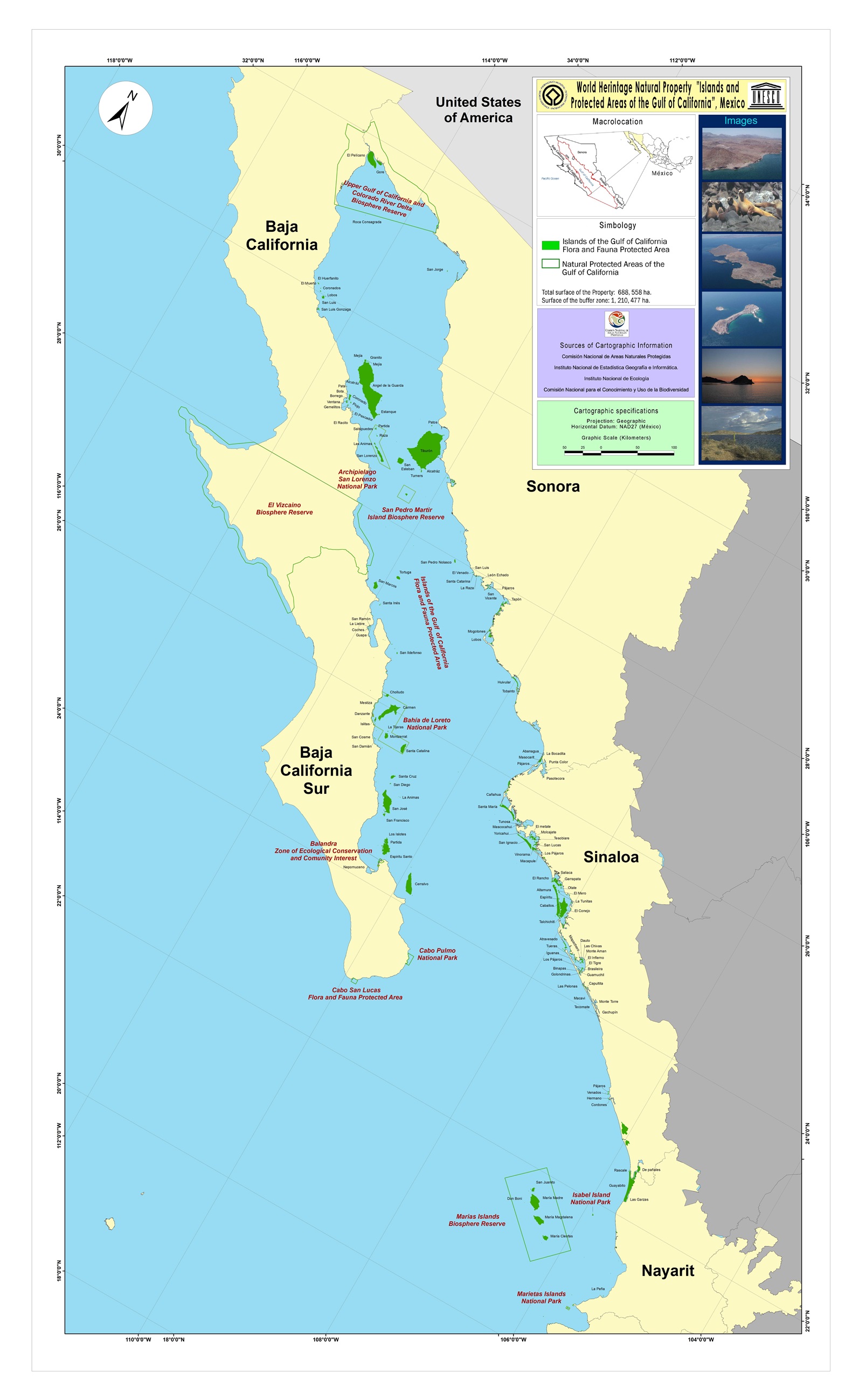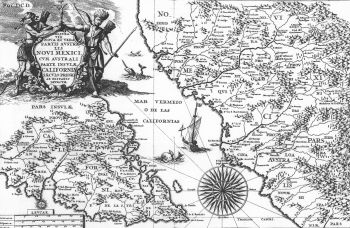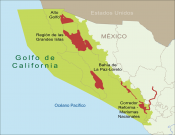Kino National Parks and Heritage Areas
CONSTRUCTION NOTES
Most links in the this column are not activated to got to this website at this time. Some links will go to the saved Wayback Machine pages.
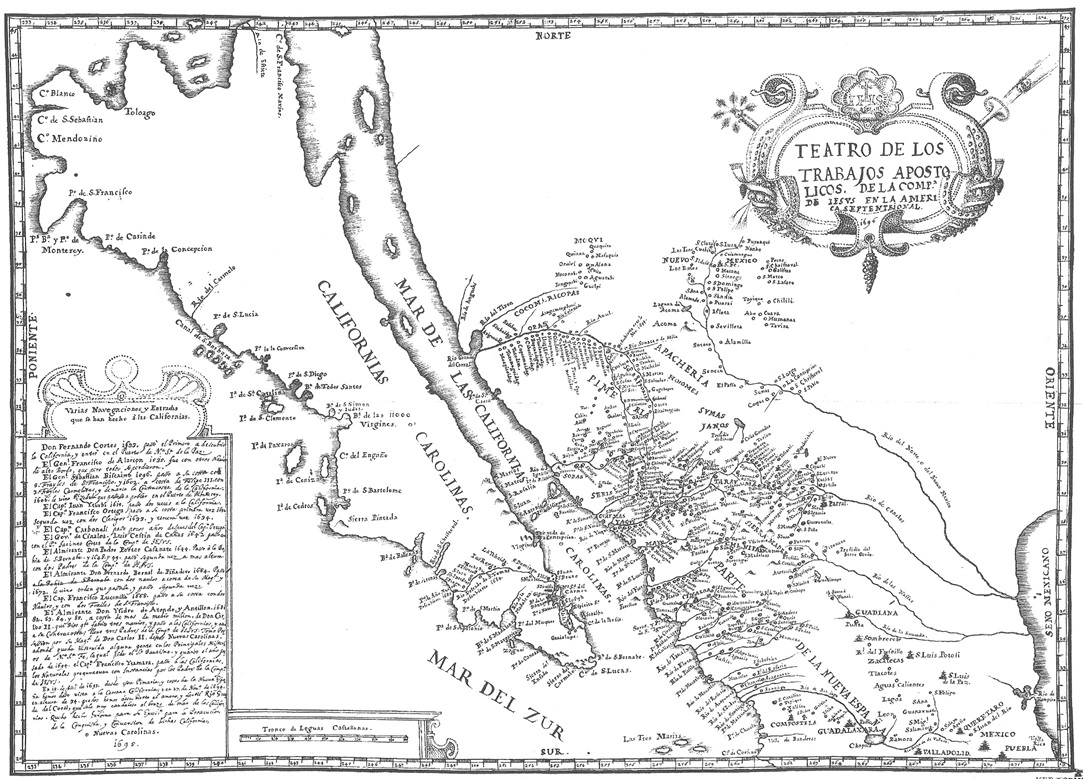
Kino Hand Drawn Map Teatros 1696
Kino's New World Travels
Kino sailed the waters and rode across lands set aside by the national governments of the United States and Mexico and the state governments of the Baja Califorias, Sonora and Arizona. These protected areas are being perserved for natural, cultural and historical conservation purposes. Below are national parks, monuments, reserves and wildlife refuges that are associated with Kino's journeys of exploration.
They are set out in chronological order using the first year of Kino's discovery togther with the duration of his years of contact. Below the title of each protected area is a link to an website for more information.
For website page links to maps and descriptions of Kino's sea voyages and land journeys,
Click Explorations.
The landscapes and seascapes of many of the protected areas that Kino traveled can be viewed by watching the natural history and travel series "The Desert Speaks" and "In the Americaswith David Yetman." Below on this page are references made to the program title and its episode number for the protected area. The Emmy winning Desert Speaks series produced by KUAT-TV is distributed by American Public Television and hosted by Dr. David Yetman. An entire episode list with program summaries is at APT.
"In the Americas" is distributed by The Southwest Center of the University of Arizona.
To view 8 seasons of episodes online,
Click In the Americas.
Editor Notes
Baja and Gulf of California and Other Sea Voyages
Gran Isla de las Californias
United Nation's Conservation Report
Gulf of California Islands and Protected Areas
For Report describing fauna, flora and environment
Click Gulf Description
For Peninsula of Baja California Mapguide
Natiional Geographic Tourism
Click Baja
For Gulf of Californa Maps
Click Protected Gulf
Reserva de la Biosfera Marismas Nacionales
Sinaloa and Nayarit
1681 - 1687
1695 - 1696
Kino made many trips back and forth along today's Biosfera Marismas Nacionales during the 2 years he prepared with Atondo to set sail to Baja California. After 3 years in Baja, Kino received a new assignment to work in today's Sonora and Arizona. He again rode along the familiar mangrove coast. Later in late 1695 he would return to the biosphere reserve when he rode to Mexico City from Mission Dolores in 53 days and then back in early 1696.
Reserva de la Biosfera Marismas Nacionales is one of Mexico’s most important wetland ecosystems with an area of an area of 2,000 square kilometers (770 sq mi). Stretching along the Pacific coast from Mazatlan, Sinaloa to San Blas, Nayarit. it contains the most extensive mangrove complex on the Pacific coast of Mexico, as well as numerous lagoons, ponds, mudpans, and other wetland habitats.
Click
https://whsrn.org/whsrn_sites/marismas-nacionales/
Islas Marías, Islas Marietas and Isla Isabel National Park
1682 - 1686
Kino first began his first New World missionary efforts by passing between these islands and today's Riveria Nayrita as the Atondo-Kino Expediton first set sail from the port of Chacala to colonize Baja California .
Click Islas Marias
Click Islas Marietas
Click Isla Isabel
Balandra Zone of Ecological Conservation & Community Interest
1683
Near La Paz, Baja California Sur
The "Balandra" was the name of the remaining of three ships that the Atondo-Kino Expedition sailed to Baja.
Click Balandra
The Desert Speaks
"Navigating a Desert Island" - Episode 1802
More about The Desert S
Bahía de Loreto National Park and
Isla Espíritu Santo Migratory Flora and Fauna Reserve
1683 - 1685
Gulf of California and islands near Loreto, Baja California Sur
Click Bahía de Loreto
The Desert Speaks
"Marine Sanctuary: Preserving Desert Life" - Episode 1803
Video: Loreto, Baja California Sur. Discover, Explore & Experience | Edición Aventura
Click Loreto Video
Reserva de la Biosfera Sierras La Giganta y Guadalupe
1683-1685
Kino found passage through the Sierras La Giganta and lead first European crossing of today's Baja Peninsula from gulf of California to the Paciific Ocean.
Mexico's most recent protected area established November 2020
Click Sierras La Giganta y Guadalupe Proposal
Isla San Pedro Martir
1685
Click Isla San Pedro
Islas del Golfo de California and Tiburon
1685; 1706
Kino is becalmed on Tiburon Island for 6 weeks and ministers to Seri people.
Click Tiburon
The Desert Speaks
"Baja Journeys: Volcanoes / Oceans" - Episode 1311
San Lorenzo Marine Archipelago National Park and El Vizcaíno
1685
Kino sails along the islands and coastal belt of El Vizcaino looking for new mission sites.
Click San Lorenzo
Click El Vizcaino
The Desert Speaks
"Desert Whales" - Episode 1301
"Baja People: Oases / Mountains" - Episode 1312
"Baja Boojums: Bizarre Plants" - Episode 1313
"Sea of Cortez: Then and Now" - Episode 1801
Parque Nacional El Veladero de Acapulco
November 1686
Kino sails down the Pacific coast from the port of Matanchel to Acupulco to escort the Manilla Galleon who were under threat from Dutch pirates.
Click
El Veladero
La Reserva de la Biosfora Sierra de Huautla
1686
Kino passed through this arid tropical desert in today's state of Morelos on his way to Mexico City from Acapulco after disembarking from a ship that protected the Manilla Galleon from Dutch pirates.
Click Tropical Desert
La Reserva de la Biospera Mariposa Monarca
1687
Kino travels through this protected area on several trips to Mexico City while advocating for a retrun to Baja. Kino again passes by while making his trip north to the unknown Pimería Alta where he will work for his last 24 years.
Clcik Monarch Butterfly Biosphere Reserve
Sonora and Arizona
Pimería Alta
Arizona - Sonora Desert Region Map Guide
National Geographic Geotourism
Map Guide in English
Click in English
Map Guide in Spanish
Click en Español
Meseta De Cacaxtla Nature Reserve
1687
Click Meseta De Cacaxtla
Sierra de Álamos - Río Cuchujaqui
1687 - 1697
Click Sierra de Álamos
The Desert Speaks
"Visiting Ancient Mayo Lands" - Episode 1310
Coronado National Forest
Madrean Sky Islands
1687 - 1711
Coronado National Forest
Madrean Sky Islands Mountains In United States
Kino worked and traveled in the Madrean Sky Islands of both in Mexico and United States.
Click Coronado National Forest
In the Americas
"Islands in the Desert"
Episode 6 of Season 8
Program 806
Tumacácori National Historic Park
1691 - 1704
Kino first journey of exploration from his Mission Dolores headquarters. Tumacâcori National Historic Park includes the Tumacácori, Guevavi and Calabasas mission sites.
Click Tumacácori
Mission San Xavier del Bac
1792 - 1704
This operating parish church located on the Tohono O'odham Nation is the finest example of the Moorish - Baroque architecture in the United States. It is perserved through the work and the private donations made to the Patronado San Xavier.
Click Mission San Xavier and Patronado San Xavier.
The Desert Speaks
"Living Traditions of the Tohono O'odham" - Episode 1410
"Ageless Mud: Adobe Homes in the Desert" - Episode 1710
San Pedro Riparian National Conservation Area
1692 - 1704
Kino makes many journeys to see Sobaípuris and Chief Coro who lived near today's ghost town of Fairbank near Tombstone.
Click San Pedro
Click Fairbank HistoricTownsite
The Desert Speaks
"The Gadsden Purchase, Part 2" - Episode 1902
Las Cienegas National Conservation Area
1692 - 1704
Click Las Cienegas
Kino also traveled in Pima County's Empirita Ranch that adljoins the Las Cienegas National Conservation Area.
San Raphael State Natural Area - Arizona
1692 - 1708
Click San Raphael Ranch
Sahuaro National Park
1692 - 1704
Kino will make many trips through the Sahuaro Forests as he travels to and from the Gila and today's Tohono O'odham Reservation. Also he traveled in Pima County's Tucson Mountain Park that adjoins Sahuaro National Park - West.
Click Sahuaro Park
Cerro de Trincheras
1693
Kino on return trip to and from the Northern Gulf coast is first European to see largest trinchera complex.
Zona Arqueológica Cerro de Trincheras
Recently opened visitors center and museum.
Click Trincheras
Ironwood Forest National Monument
1694 - 1700
Click Ironwood Forest
Picacho Peak State Park - Arizona
1694 - 1700
Click Picacho Peak
Casa Grande Ruins National Monument
1694 - 1700
Kino was first European to see the Casa Grande Ruins.
Click Casa Grande Ruins
The Desert Speaks
"River Runs Dry" - Episode 1305
Hohokam Pima National Monument
1694 - 1700
Click Hohokam Pima
Area Natural Protegida Campo Verde
1696
Campo Verde
Sonoita Creek State Natural Area - Arizona
1697
Click Sonoita Creek
Patagonia Lake State Park - Arizona
1697
Click Patagonia Lake
Ajos - Bavispe National Forest Reserve and Wildlife Refuge
1697 - 1710
Clcik Ajo - Bavispe
The Desert Speaks
"The Lost Palm Weavers of Sonora" - Episode 1404
"Jaguars and Vaqueros" - Episode 1906
"Dying Traditions in a Mexican Pueblo" - Episode 1909
Sonoran Desert National Monument
1698 - 1700
Click Sonoran Desert
The Desert Speaks
"Beyond the Asphalt - Part 1" - Episode 1903
Organ Pipe Cactus National Monument
1698 - 1701
Clcik Organ Pipe
The Desert Speaks
"Heart of the Sonoran Desert" - Episode 1206
"Desert Missions" - Episode 1207
"Of Drought and Fire" - Episode 1612
The Desert Speaks
"The Gadsden Purchase, Part 2" - Episode 1902
Cabeza Prieta National Wildlife Refuge
1698 - 1701
Clcik Cabeza Prieta
La Reserva de la Biosfera El Pinacate y Gran Desierto de Altar
1698 - 1706
Kino is the first European to climb the Pinacates and see its extensive craters and volcanic fields and is stopped by the Great Dunes of the Colorado.
Click for Reserve's web page
Pinacate
Click for Kino's three explorations
Pinacate and Gran Desierto
In the Americas
"Mexico's Sierra Pinacate"
Episode 5 of Season 6
Program 606
For entire 25 minute program
Click
https://intheamericas.org/programs/season-6/
The Desert Speaks
"Tracks in the Shifting Sand" - Episode 1406
Great Bend of the Gila National Monument - Proposed
1699 - 1700
Kino is the first European to travel along the Gila River from its junction with the Colorado River to Casa Grande. Later the trail first traveled by Kino is used by Anza Expedition 70 years later to settle California.
The National Trust for Historic Preservation has identified the proposed Great Bend of the Gila National Monument as the most important BLM cultural sites of the Southwest. There is a bill pending in the United States Congress authorizing its creation the national monument..
To view and download the study on the significance of the cultural resources and natural landscape recently released by Archaeology Southwest and the National Trust for Historic Preservation
Click "The Great Bend of the Gila: A Nationally Significant Cultural Landscape"
For Dr. David Doyel's 39 minute video presentation
Click The Archaeology Cafe
Painted Rock Petroglyph Site
1699 - 1700
Kino is the first European to travel along the Gila River from its junction with the Colorado River to Casa Grande.
Sierra Estrella Wilderness
March 1699
On his return from his first Colorado River exploration, Kino climbs the Sierra Estrellas and views and names the Verde and Salt Rivers. Also he traveled in Maricopa County's Estrella Mountain Regional Park.
Click
Estrella Wilderness
Buenos Aires National Wildlife Refuge
1699 - 1700
Clck Buenos Aires
Yuma Crossing National Heritage Area
1700 - 1701
Kino is met by 1,700 native people of the Lower Colorado River Valley on his second and 4,000 native people on his third of a total of four visits to the Lower Gila river and the Colorado river and its delta.
Click Yuma Crossing
The Desert Speaks
"The Gadsden Purchase, Part 2" - Episode 1902
"Beyond the Asphalt, Part 1" - Episode 1903
Reserva de la Biosfera Alto Golfo de California y Delta del Rio Colorado
1701
Kino travels to the end of the Colorado River Delta to first prove that California was not an island as commonly believed but that California could be supplied by land.
Clck Colorado River Delta
Reserva Especial de la Biosfera Cajón de Diablo
1708
Kino blazes new cattle trail to Guaymas port to supply restated Jesuit missions in Baja.
Click Cajón de Diablo
The Desert Speaks
"Life Along the Rio Sonora" - Episode 1507
"Sonora's Forgotten River" - Episode 1711
Monumento Nacional al Padre Kino
1711
Father Kino National Monument
The masoleum is on the grave site where the Kino's skeletal remains where found by international team of scientists in 1966. It became a national monument of Mexico in 1971. It is located in the town square of the Magdalena de Kino .
The Kino Festiival is celebrated in Magdalena de Kino and throughout Sonora and Arizona during the week of the anniversary of the discovery on May 21st.
Click Grave Discovery
The Desert Speaks
"Sonora's Forgotten River" - Episode 1711
"Pilgrimage to a Party" - Episode 1511
Other Kino Cultural and Protected Areas
Parco Naturale Adamello-Brenta - Trentino, Italy
1645 - 1663
Kino was born and grew up in the village of Segno in the Val di Non, the sunnest valley in the Alps. On the western side of the Val di Non is the Parco Naturale Adamello-Brenta of the Province of Trent, Italy The park comprises 650 square kilometers (250 sq. miles). The park's elevations range from 400 meters to 3,500 meters with fauna that is among the richest of the Alps. The park protects the last bear habitat in Italy and also protects habitat of the golden eagle, wood grouse, chamois and alpine ibex. The park is a UNESCO World Heritage Site. A foot trail starts near Segno that ends in the heart of the Brenta Mountains via the Passo Grostèto at the village of Madonna del Campiglio.
Click Parco Naturale Adamello-Brenta
Parco Nazionale dello Stelvio - Trentino, Italy and Central Alps
1645 - 1663
On the north west side of the Val di Non is Parco Nazionale dello Stelvio (Stelvio National Park). It is in the heart of the central Alps. It is the largest park in the Apls and Italy. Three quarters of the park is above 2,000 meters with its highest peak is 3,905 meters. Stelvio National Park borders the Swiss National Park and Parco Naturale Adamello-Brenta Together these parks comprise 400,000 hectares (1,500 sq.miles) of protected natural environment.
Click Stelvio National Park
For a list of all parks, reserves and protected areas and parks in the Province of Trent - Alto Adige -
Click Trentino Protected Areas
Hall in Tyrol - Austria
Jesuit Gymnasium
1662 - 1664 - Student
1670 - 1673 - Teacher
In 1661 after two years as a student, Kino graduates from the Jesuit Gymnasium in Hall In Tyrol (then called Hall am Inn).
In 1670 Kino returns to Hall am Inn as a Jesuit novice to teach for three years rhetoric, grammar and literature at his Jesuit Gymnasium alma matter. The Jesuit Gymnasium building was destroyed by an earthquake in July 17, 1670.
Hall in Tyrol with its Old Town center is an outstanding example of a town of the Medieval and Renaissance era with its Romanesque, Gothic and Baroque architecture. It impressively demonstrates its historical importance as a former European economic center that was funded by nearby salt and silver mine extraction and assocated processing.
It was the location of the Sovereign Mint of the Hapsburg Empire. Also it was a key transport and communication center with its location on the Via Imperii, the major transportation route between Central Europe and Italy over the Alpine Brenner Pass and with its port for navigation down the Inn River. Its rich secular and ecclesiastical architecture is well preserved with its original buildings and street plan that were spared the destruction of World War II.
Today Hall in Tyrol is a popular Alpine vacation destination with 13,000 inhabitants. It is located 5 kilometers east of Innsbruck, the capital of the Austrian Tyrol.
UNESCO has accepted Austria's application of the Burg Hasegg castle complex with the Hasburg Sovereign Mint and has added it to UNESCO's tentative world heritage site list.
See
https://www.blog.tirol/en/2017/03/a-town-steeped-in-history-a-day-in-hall-in-tirol/
Parque Nacional de Doñana - Spain
1678-1681
Kino lives for three years in Andalusia while waiting for passage across the Atlantic to the New World. He makes numerous trips between Cadiz and Seville via the Guadalquivir River.
Parque Nacional de Doñana, recognized by UNESCO as a World Heritage site, is a natural reserve of of marshes, shallow streams, and sand dunes in the Guadalquivir River Delta near Cadiz.
Click
Doñana National Park
Parque Nacional Pico de Orizaba - Mexico
1681
Kino travels along the southern foothills of Orizaba Volcano on his way to Mexico City from the sea port of Vera Cruz after crossing the Atlantic.The Orizaba Volcano at 18,491 feet has glaciers and snow year round. It is the highest mountain in Mexico and highest volcano in North Armerica. As part of the Sierra Madre Oriental, Orizabe separates the lowland tropical forests along the coast of the Gulf of Mexico from the hihger pine-oak forests of the Trans-Mexican Volcanic Belt.
Click Orizaba
El Tepeyac National Park - Valley of Mexico
1681; 1684 - 1686; 1696
While in Mexico City, Kino would travel daily north from the capital five miles to pray at Tepeyac Hill where Virgin of Guadalupe appeared in 1531.The Tepeyac National Park is in the Sierra de Guadalupe that forms the northern boundary of the Valley of Mexico. The park includes within its boundaries Tepeyac Hill and the Basílica de Nuestra Señora de Guadalupe, the world largest site of pilgrimage. Also included within in the park are the Cerro de Guerrero and the Cerro de Santa Isabel. Tepeyac National Park together with other govermental reserves comprises the largest urban reserve in Latin America.
Click
Tepeyac National Park
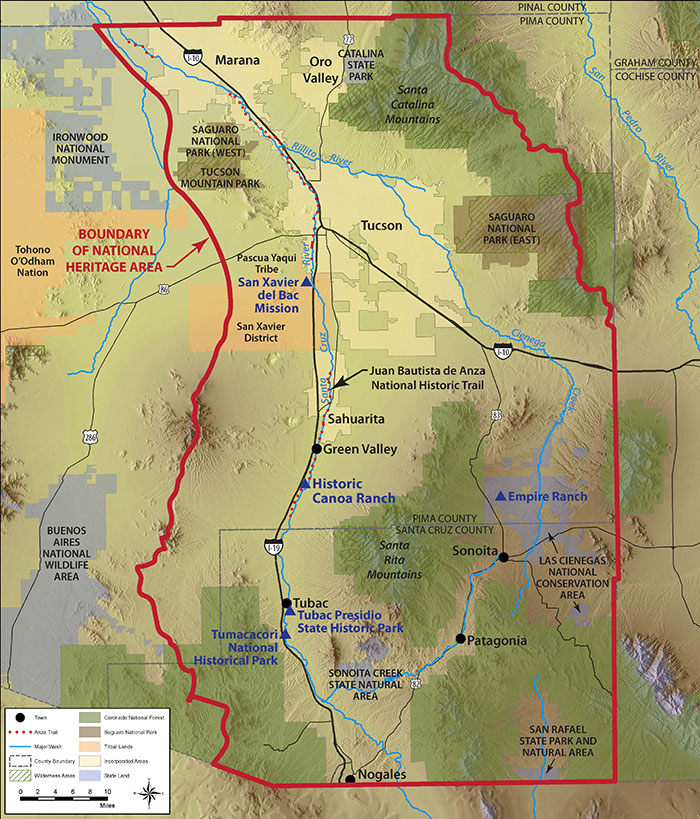
Santa Cruz Valley National Heritage Area
U.S. National Park Service - Southern Arizona
Santa Cruz Valley National Heritage Area - Arizona
1691 - 1704
The United States Congress designated the Santa Cruz Valley National Heritage Area as a place “where natural, cultural, historic and recreational resources combine to form cohesive, distinctive landscapes of national significance arising from patterns of past and present human activities shaped by geography." The heritage area encompasses the major watersheds of the Santa Cruz River in Santa Cruz County and Pima County in southern Arizona. See map above.
Click
Santa Cruz Valley National Heritage Area
Tubac Presidio State Historic Park - Arizona
Established 1752
Tubac Presidio was founded 40 years after Kino's death. Most of Kino's travels were without military escort and only as witnesses to friendliness of the O'odham people. The only Spanish military presidio during Kino's time was at Fronteras just south of today's Douglas, Arizona, fifty miles from Kino field of work.The Fronteras presidio was established five years after Kino's arrival in 1687.
Click Tubac Presdio Website
Click Tubac Presidio Video
Canoa Ranch - Arizona
Kino traveled and camped at the site of Pima County's Canoa Ranch while traveling up and down the Santa Cruz River from 1691 to 1704.
Click
Canoa Ranch
Juan Bautista de Anza National Historic Trail - United States
75 - 1776
Kino traveled the El Camino Real (Camino de la Costa or Camino real a la Sonora), New Spain's King's Highway on the Pacific shelf, the west of the Sierra Madre Occidental. On one trip, Kino rode on the El Camino Real 1,500 miles in 53 days from his Dolores mission headquarters to Mexico City to personally appear before the highest officials to protect the O'odham people.
The United States Congress in 1990 designated the El Camino Real in the United States as The Juan Bautista de Anza National Historic Trail. The 1,200 mile route begins in Nogales, Arizona and ends in San Francisco, California.
During his journeys of exploration, especially the four to the Colorado River and Lower Gila River, Kino established peaceful relationships with the Native People he encountered whiile blazing the trails that were followed by the Anza Expeditons 70 years later in today's Arizona.
Without Kino's advocacy and his supplying grain and cattle in support of the restarted Jesuit missions in Baja California, Portola and Serra would not have had Baja as their springboard for the future settlement of Alta California by the Spanish. Kino also established Pious Fund of the Californias that provided financial support for the California missions until the early 20th century.
Click Anza Trail
Hangzhou Cathedral and Defangjing Jesuit Cemetery -
Zhejiang, China
1655
Jesuit missionary and famed historian and geographer of China Father Martin Martini (1614-1661) met his 10 year old cousin Eusebio Kino in 1655 as he was traveling through his home province of Trento. Martini was returing from China after 10 years of missionary work when he met young Kino on his way to Rome. Their meeting perhaps inspired Kino's desire to serve as a missionary in China. In Rome Martini successfully defended his fellow Jesuit missionaries before Vatican authorities concerning the "Chinese Rites Affair." Martini made the difficult journey back to China and finished building Hangzhou's beautiful Our Lady of the Immaculate Conception Cathedral just before his death. He died of cholera while caring for others during an epidemic. The Hangzhou Cathedral is a Hanzchou Municipal Historic site. The Dufangjing Jesuit Cemetery where Martini is buried is a Zhejiang Province Historic site. Martini is the father of the scientific study of Chinese geography and his many books first introduced Europeans to the then little known history, geography and language of China. Martini's observations were as monumental as Copernicus in European intellectual history. European were astonished that China civilization was in existence before the then believed date for the creation of the world.
Click Hangzhou Cathedral.
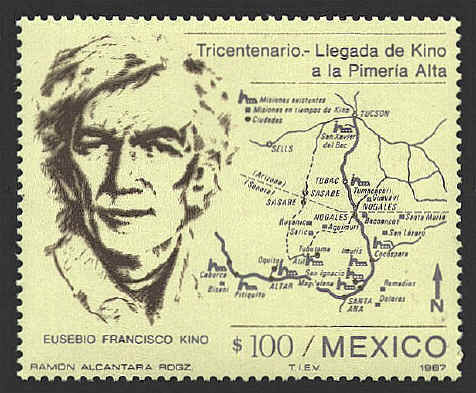
Mexico's 1987 Commemorative Kino Stamp
The 300th Anniversary of Kino's Arrival In The Pimeria Alta
The Kino International MIssion Trail
UNESCO Heritage Site - Proposed
Sonora and Arizona
1687-1711
The Kino International Mission Trail encompasses a group of frontier mission complexes situated in the Pimeria Alta - today's U.S-Mexico Borderlands in the states of Arizona and Sonora. The sites are part of the 22 missions established from 1687 to 1711 by pioneer Jesuit missionary and explorer Eusebio Francisco Kino.
The sites are along historic trails including routes of the Magdalena Pilgrimage that is made by the O'odham people to the city of Magdalena, Sonora. The O'odham people began the pilgrimage more than 300 years ago to honor Kino's memory after his death in Magdalena. Today the O'odham people are joined by 10 thousand people throughout Mexico and the United States who travel to the Magdalena in the early part of the Fall season for religious observances and civil celebrations. For more information about the Magdalena Pilgrimage, click Camino de Kino.
The sites have important architectural and archaeological structures and natural landscapes that include farmlands, residencies, churches, granaries and water distribution systems.The existing mission buildings were built on the Kino sites by Franciscan missionaries in the late 18th and early 19th centuries. The missions are examples of the interweaving of Spanish, Mexican and other European cultures with the indigenous cultures of the O'odham, Yaqui, Opata, Apache and Seri people. The decorative elements of the churches combine Roman Catholic symbology with indigenous designs.
The sites in Sonora, Mexico include the missions of San Ignacio de Cabórica, Mission San Pedro y San Pablo del Tubutama, Santa Teresa de Atil; Santa Maria Magdalena, San José de Imuris, Nuestra Señora del Pilar y Santiago de Cocóspera, San Antonio Paduano del Oquitoa, San Diego del Pitiquito, La Purísima Concepción de Nuestra Señora de Caborca and Nuestra Señora de la Ascención de Opodepe.
The sites in Arizona, United States include Mission San Xavier del Bac on the San Xavier District of the Tohono O'ohdam National in the community of.Wa:k. Also in Arizona in today's Tumacácori National Historical Park are the sites of Mission San Cayetano del Tumacácori (Mission San Jose de Tumacacori) and Mission Los Santos Ángeles de Guevavi.
Governmental entities and community organizations are in the process of submitting the application to the United Nations Educactional and Scientific and Culural Organization (UNESCO) because the sites have cultural and historic significance that is important to the collective interests of humanity.
For list of missions with photos
Click
The Kino International Mission Trail
For video of the missions with many aerial views that begins at 2.55 minute mark,
Click
Kino: Padre Sin Fronteras
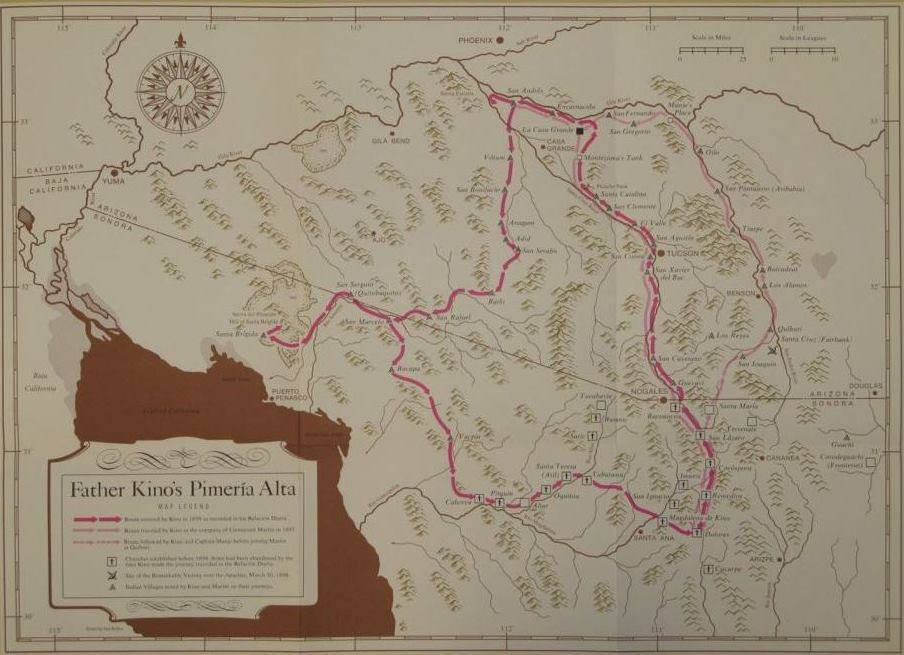
Kino's 1698 Journey Across Southern Arizona to Gulf of California
In 1698 Exploration Kino Visits
Eight National Parks & Additional Protected Areas
Kino was the first European to see, and on one of his explorations, to visit seven of today's national parks and many other protected land reserves in Southern Arizona and Northern Sonora.
In one journey of exploration in the Fall of 1698 Kino rode on horseback 500 miles in 25 days as he explored in the United States:
[1] Tumacácori National Historical Park
[2] Tohono O'odham Indian Reservation
[3] Mission San Xavier del Bac
[4] Sahuaro National Park
[5] Ironwood Forest National Monument
[6] Picacho Peak Arizona State Park
[7] Casa Grande Ruins National Monument
[8] Gila River Indian Reservation
[9] Hohokam Pima National Monument (closed to public)
[10] Ak Chin Indian Reservation
[11] Sonoran Desert National Monument
[12] Cabeza Prieta National Wildlife Refuge
[13] Organ Pipe Cactus National Monument
[14] Barry M. Goldwater Air Force Range
In Mexico, Kino explored
[15] Reserva de la Biosphere El Pinacate
[16] Cerro de Trincheras
Kino travel to the future site of the Tubac Presidio Arizona State Historic Park [17]. He trail blazed parts of the later travels on the Juan Bautista de Anza National Historic Trail [18] [1 through 11] and the proposed Butterfield Overland Trail National Historic Trail [20] [3 through 11]. In his other explorations Kino traveled these national trails in Arizona and visited other protected lands listed above in the United States and Mexico.
